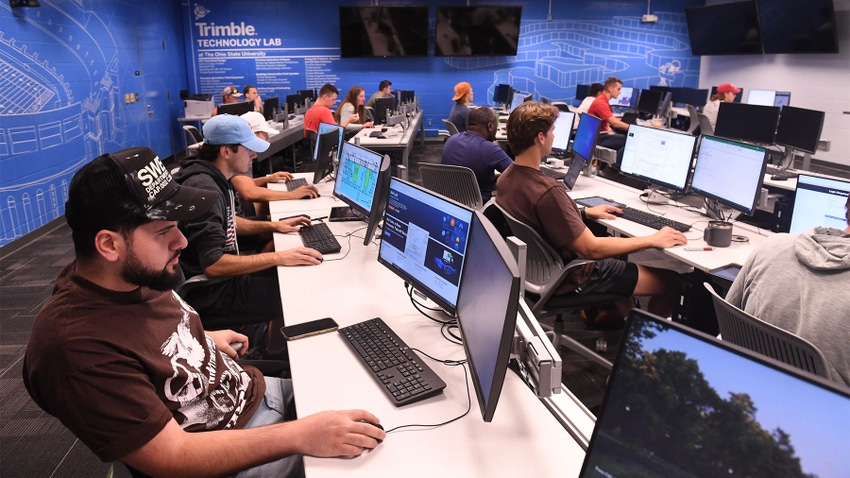
Imagine having everything that might be in the cab of today’s high-tech tractors at an indoor workstation with several students gathered around participating in hands-on learning.
That’s what is happening at Ohio State University with the recent establishment of two Trimble Technology Labs within the College of Food, Agricultural, and Environmental Sciences (CFAES).
In May 2023, OSU announced Trimble’s gift of hardware and software to be used at several customized training workstations, which include machine guidance control and steering, as well as field leveling and water management systems.
A ribbon-cutting ceremony Oct. 6 celebrated the labs — one at the Columbus campus and the other at Ohio State Agricultural Technical Institute, Wooster campus.
These multidisciplinary labs aim to enhance hands-on learning, teaching, research, and outreach activities in food and agricultural engineering, as well as construction management, using technologies used today by professionals in the industry.
Trimble is an American software, hardware and services technology company. It supports global industries in building and construction, agriculture and others. Trimble also does hardware development of global navigation satellite system (GNSS) receivers, scanners, laser range finders, unmanned aerial vehicles (UAVs), inertial navigation systems and software processing tools.
The investment is to broaden the reach for students and to familiarize and access jobs in the agriculture industry.
“In recent years, farming and construction industries have faced crucial labor shortages and skilled labor gaps,” says Jim Chambers, vice president, agriculture, Trimble. “With the added technology in these labs, we’re looking to not only attract the next generation of agriculture and construction professionals, but we hope to attract a whole new subset of students looking for technology careers that may not have realized a career in agriculture or construction could be for them.”
According to the university, it is the largest philanthropic gift-in-kind investment to support teaching, research and outreach in the history of CFAES.
Engaging students
In its inaugural year, more than 1,000 students will have access to the labs for courses dedicated to the next generation of agriculture and construction careers.
“We do a lot of hands-on learning here, but this expands that ability,” says Jon Witter, an associate professor in the Agricultural and Engineering Technologies Division at Ohio State ATI.
“We do a lot of project-based learning here on campus — we're doing things that they're doing in industry and developing marketable skills. I think that's incredibly valuable helping young people figure out what career paths they want to go.”
The workstations are designed to replicate what happens in the field.
“I think we do a good job in the classroom,” Witter says. “But what you're seeing in the class has got to translate to a useful skill in the real world. We’ve worked with Trimble for years — about six years with water management training — but this is really going to change the way we do things.”
By starting in the workstation lab setting, moving to technology-equipped ATV's and then to full-sized agricultural and construction equipment, learners have more opportunities to master the skill sets needed to excel in precision farming and construction management, he says.

GYM CONVERSION: At the Ohio State ATI at the CFAES Wooster campus in Ohio, a former gymnasium is being converted to a Trimble Technology Lab. This photo with Jon Witter, associate professor in the Agricultural and Engineering Technologies Division at Ohio State Agricultural Technical Institute, and Ben King, coordinator of construction technology at Ohio State ATI, was taken in September as they prepared the area for workstations.
The Wooster campus, one of four regional Ohio State campuses, has repurposed a former 4,000-square-foot gymnasium to serve 12-18 students at a time in the new lab. The Wooster campus primarily serves undergraduates in obtaining associate degrees. “There’s an incredible demand for students with associate degrees, and this hands-on learning only adds value,” Witter adds.
While one workstation may have everything found in the tractor cab, such as GPS and autosteer, another station will have everything that goes on the implement, like various applicators, sensors and meters.
“It’s really an exciting opportunity, not only for our traditional students, but also for others who want to come back and learn more about technology or perhaps learn to do something rather than paying an agronomist to do it,” Witters says.
Ohio State University Extension will help support training programs to equip farmers and agricultural professionals with technologies. The labs will not only be used for workforce development opportunities, but also for faculty research purposes, local youth agriculture groups such as Ohio 4-H youth development, FFA and local field days.
The labs will also offer opportunities for worker training outside of the usual university, for-credit courses by offering targeted workshops for certifications — appealing to current farmworkers, local dealers or businesses in the industry.
In recognition of Trimble’s contribution, it was presented with the Corporate Partner of the Year Award from the National Agricultural Alumni Development Association, a national philanthropic association for agricultural education institutions. To learn more, visit trimble.com.
Read more about:
EducationAbout the Author(s)
You May Also Like






